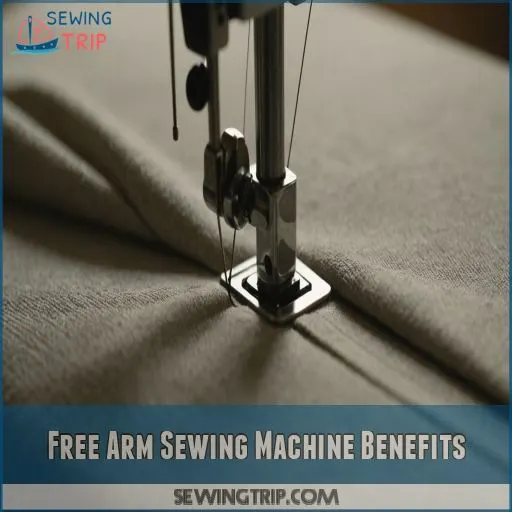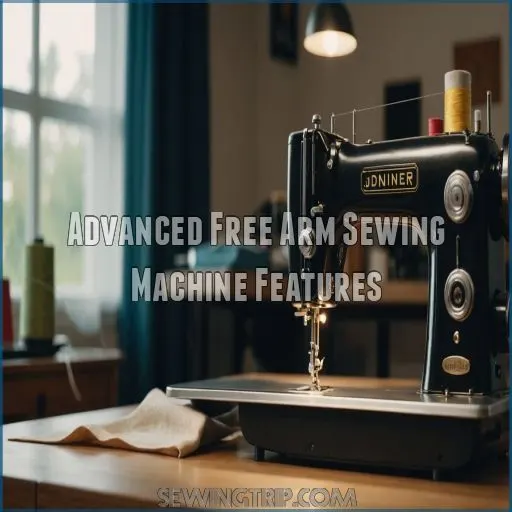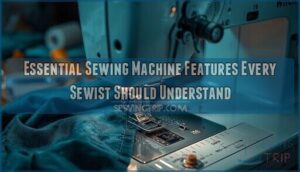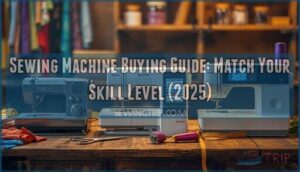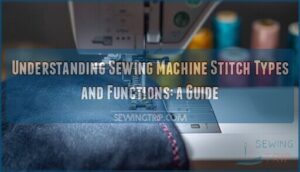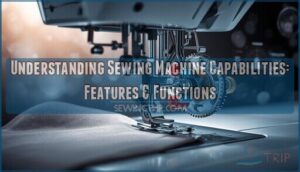This site is supported by our readers. We may earn a commission, at no cost to you, if you purchase through links.
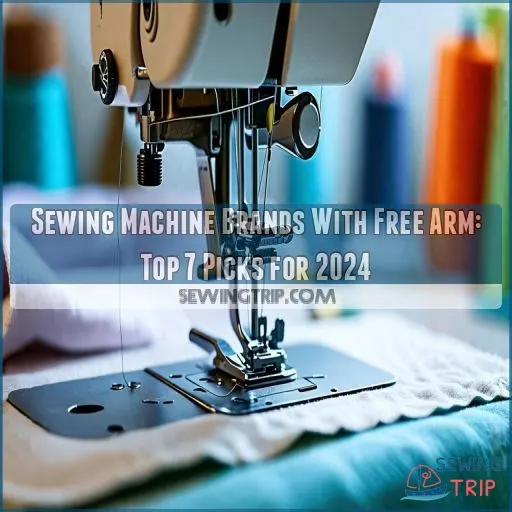
These machines let you tackle tricky sleeves and cuffs like a pro. With a free arm, you’ll glide through tubular projects, leaving fabric-wrestling nightmares behind.
Imagine zipping through pants hems without breaking a sweat! Free arm machines offer better stitch control and quality, perfect for both beginners and seasoned sewists.
When choosing, consider features like automatic threading and adjustable stitch settings. Remember, the right machine feels smooth and easy to use.
But here’s the real kicker: some advanced models boast features that’ll make your sewing projects a breeze.
Table Of Contents
Key Takeaways
- You’ll find top brands like Janome, Singer, and Brother offering free arm machines that’ll make sewing sleeves and cuffs a breeze. It’s like having a secret weapon for those tricky tubular projects!
- When choosing your free arm sidekick, consider features like automatic threading and adjustable stitch settings. They’re not just bells and whistles – they’ll save you time and frustration, letting you focus on unleashing your creativity.
- Free arm machines aren’t just one-trick ponies. They offer better stitch control and quality, making them perfect for both beginners and seasoned sewists. You’ll be zipping through projects faster than you can say "bobbin"!
- Don’t forget to weigh the pros and cons of free arm vs. flatbed machines. While free arms are great for maneuvering tight spots, flatbeds offer more support for larger projects. It’s like choosing between a sports car and a pickup truck – both have their place in your sewing garage!
Free Arm Sewing Machine Benefits
Tired of wrestling with your fabric while sewing?
A free arm sewing machine is a game-changer, making it a breeze to tackle those pesky sleeves, cuffs, and pant legs.
With its suspended bed and reduced fabric manipulation, you’ll zip through projects faster and enjoy better stitch quality.
Reduced Fabric Manipulation
A free arm sewing machine reduces fabric manipulation, making your sewing life a breeze.
Experience:
- Sewing Ease: Glide fabrics smoothly, transforming tough sleeves into a cinch.
- Precision Control: Achieve seamless stitches with less puckering and perfect curves.
- Smooth Curves: Handle cuffs and hems like a pro.
- Faster Projects: Spend more time creating, not fussing with fabric twists.
Increased Efficiency and Speed
Imagine this: you’re zipping through sewing projects like a pro with a free arm sewing machine.
These clever devices use time-saving techniques and sewing hacks to boost your speed without breaking a sweat.
Unlike flatbed machines, they let you tackle tubular and cylindrical pieces effortlessly.
Whether domestic or semi-industrial, they’re your go-to for efficient sewing and speed tricks .
Better Stitch Quality and Control
You’ve boosted efficiency, so now focus on stitch quality and control.
A free arm sewing machine helps you master:
- Stitch Consistency: Perfect for varied fabric types.
- Needle Tension: Enhances control over sewing techniques.
- Foot Pressure: Makes even decorative stitches.
- Built-in Stitches: Explore diverse stitch length settings.
A stellar machine can make all the difference in your craft.
Easier Cylindrical and Tubular Sewing
Tackling tricky sleeves or the hems of pants?
A free arm sewing machine offers you the flexibility you crave, especially for sewing sleeves and pants with Singer machines.
This handy feature makes sewing cylindrical items like socks and doll clothes a breeze, freeing you from fabric-wrestling nightmares.
Think of it as your sewing sidekick, perfect for mastering tubular projects without the hassle.
Choosing a Free Arm Sewing Machine
When choosing a free arm sewing machine, focus on features like automatic needle threading and adjustable stitch settings to make your projects smoother and faster.
Whether you’re a beginner or a seasoned stitcher, finding the right combination of built-in stitches and buttonhole options can save time and elevate your sewing game without adding any unnecessary frustration.
No additional lines were available to separate.
Factors to Consider for Beginners
When diving into free arm sewing machines, think about your budget, machine size, and key features like stitch types and thread tension.
Consider ease of use if you’re new to hobby sewing. Compare Janome and Bernina prices to find a balance between quality and affordability Bernina vs Janome.
Remember, handling those sewing machine needles should feel as smooth as butter.
Key factors to consider include quality and affordability.
Automatic Needle Threader and Cutter
An automatic needle threader and cutter can be a game-changer, saving you time and frustration.
Look for models with a built-in thread cutter that snips the thread cleanly.
The needle threader should work smoothly, handling a variety of thread types with ease.
These handy features let you focus on your sewing, not the setup.
Adjustable Stitch Length and Width
After an automatic needle threader, adjustable stitch length and width are your next best friends.
Dialing in on stitch control enhances your sewing projects immensely.
Consider these tips:
- Seam Types: Customize straight and zigzag stitches.
- Fabric Types: Adjust for thick denim or delicate silk.
- Embroidery Effects: Add flair with precision.
- Project Tips: Master computerized or industrial sewing machines effortlessly.
Built-in Stitches and Buttonhole Options
Adjusting stitch length and width is just the tip of the iceberg.
You’ll want a machine with diverse built-in stitches and versatile buttonhole options for creative freedom.
Imagine choosing from various stitch types and customizing buttonholes effortlessly.
Brands offer automatic features that streamline stitch selection, enhancing your control over design intricacies while boosting your sewing prowess .
Top 7 Sewing Machine Brands With Free Arm
When you’re searching for the top sewing machines with free arm capabilities, you’ll find trusted brands like Janome, Singer, and Brother leading the pack, as well as advanced models with features like stitchprecision2 technology.
These brands offer a variety of options that blend ease of use with technical features, giving you the tools you need to complete your sewing projects with precision and speed.
1. Janome Fastlane Fuschia Sewing Machine
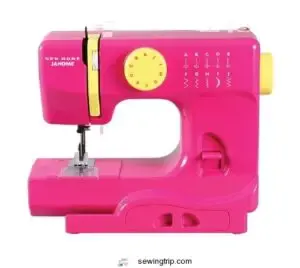
The Janome Fastlane Fuschia Sewing Machine is your go-to compact powerhouse, perfect for beginners and young sewists.
Weighing just 5 pounds, it boasts a free arm and four essential stitches for basic projects.
Though it lacks fancy features like a needle up/down button, its lightweight design makes it ideal for classes or tight spaces.
Threading challenges aside, it’s like a trusty little sidekick, reliable for simple mending and fun crafting adventures, but maybe stash a flashlight nearby—there’s no built-in light!
Best For: This machine is best for beginners, children, or anyone looking for a lightweight and portable machine for basic projects.
- Lightweight and compact
- Easy to use
- Good quality stitches
- No light
- Can be difficult to thread
- No needle up/down button
2. Singer Start 1304 Sewing Machine
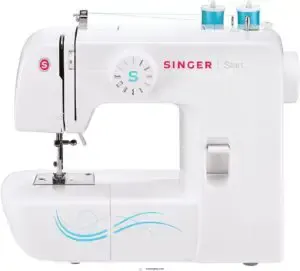
Don’t underestimate the Singer Start 1304’s versatility.
Perfect for beginners, its lightweight design makes it a breeze to carry to sewing class. With six essential stitch types, you’ll conquer those simple fixes or crafty projects without breaking a sweat.
Though affordable, the machine’s sturdy metal frame promises durability during your sewing adventures.
However, keep an eye on that tricky foot pedal and the manual’s brevity.
Mastering this machine provides the freedom to transform fabric into personal masterpieces, sure to impress.
Best For: Beginners who want a simple and affordable sewing machine for basic projects.
- Lightweight and portable for easy transport.
- Affordable price point makes it a great value for beginners.
- Sturdy metal frame ensures durability for basic sewing projects.
- Limited stitch options might not be sufficient for advanced projects.
- Some users reported a stiff, short cord and sliding foot pedal.
- The brief manual might require supplemental online resources.
3. Brother ST371HD Sewing Machine

With its sturdy structure and versatile features, the Brother ST371HD Sewing Machine stands out for those ready to tackle diverse projects.
Built for durability, it easily handles everything from delicate silks to rugged denim. Boasting 37 built-in stitches, an automatic needle threader, and a jam-resistant bobbin, it’s perfect for both beginners and seasoned sewists.
The free arm simplifies sewing cuffs and sleeves, making it as practical as a Swiss army knife of sewing machines—without the confusing gadgets. This machine is especially useful for tasks that require sewing in the round.
Additionally, the free arm feature prevents fabric bunching and reduces the risk of accidentally stitching multiple layers together, making it ideal for handling tubular pieces like sleeves and pant hems.
Best For: The Brother ST371HD is best for beginners and experienced sewists looking for a durable, versatile sewing machine with a good range of features.
- Durable construction with metal needle plate for smooth fabric feeding.
- Wide range of stitches and features for different projects.
- Free arm for easy sewing of cuffs, sleeves, and other round items.
- May need additional bobbins for various projects.
- Some users report issues with cheap thread.
- Bobbins are not interchangeable with other models.
4. Singer Tradition 2259 Sewing Machine
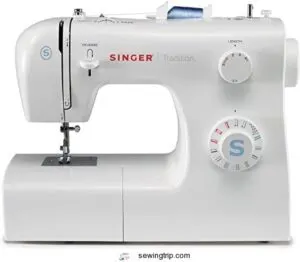
Check out the Singer Tradition 2259, a budget-friendly sewing marvel that packs a punch.
This lightweight machine boasts 19 built-in stitches, including a 4-step buttonhole, making it a versatile choice for beginners and occasional sewers . While some owners report issues with thread tension and the side-loading bobbin, the majority praise its ease of use and quiet operation .
With a sturdy metal frame and a 25-year limited warranty, the Singer 2259 is a solid investment, especially if you’re seeking a compact, portable sewing companion.
Best For: The Singer Tradition 2259 is a great option for beginners, occasional sewers, and those looking for a portable backup machine.
- Easy to use and thread.
- Durable and well-made.
- Offers a good value for the price.
- Lightweight, which can cause some movement during fast sewing.
- Side-loading bobbin can be tricky for some users.
- Reverse lever placement may take some getting used to.
5. Brother 35 Stitch Convertible Sewing Machine
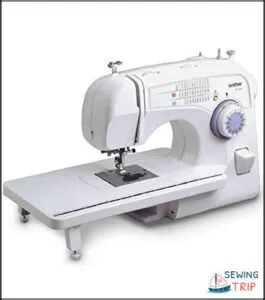
Flip open the Brother 35 Stitch Convertible Sewing Machine, featuring an Automatic Needle Threader, and you’ll find its versatility impressive.
This lightweight marvel offers 35 stitches and a convertible free arm, making it ideal for cuffs and sleeves.
With automatic needle threading and a drop-in bobbin, you’ll breeze through projects faster than you can say "sew it up" (Source).
A quilting table and seven presser feet are included, but be mindful of its limitations with thick fabrics.
It’s perfect for those seeking flexibility and ease.
Best For: The Brother 35 Stitch Convertible Sewing Machine is best for beginners and hobbyists seeking a versatile and user-friendly sewing machine.
- Lightweight and convertible for easy handling
- Automatic needle threading and drop-in bobbin for convenience
- Includes quilting table and seven presser feet for versatility
- Not recommended for thick fabrics
- Some users experience bobbin thread jams
- The quilting bed is smaller than expected
6. Janome 2206 Sewing Machine
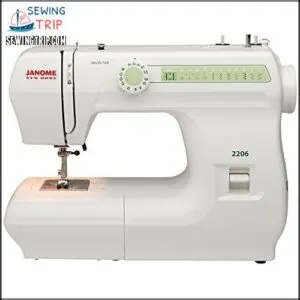
The Janome 2206 sewing machine offers a practical balance between simplicity and versatility, making it ideal for beginners and returning sewists with a free arm like the ones found in best janome sewing machines.
With features like a user-friendly stitch selection dial, free arm, and drop feed, it handles everyday sewing tasks with ease.
Though it only has six built-in stitches and may struggle with thicker fabrics like fleece, its reliability and ease of use are notable.
If you’re looking for a straightforward machine to grow your skills, the Janome 2206 is a solid choice.
Best For: The Janome 2206 is best for beginners and returning sewists looking for a straightforward machine to tackle everyday sewing tasks.
- Easy to use and reliable
- Features a user-friendly stitch selection dial
- Includes a free arm and drop feed for added versatility
- Limited stitch length options
- May struggle with thicker fabrics like fleece
- Not recommended for heavy-duty sewing tasks
7. Singer 1507WC Sewing Machine
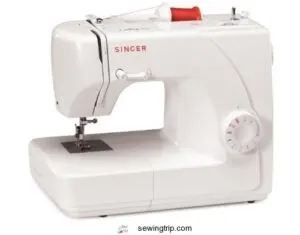
If you’re eyeing the Singer 1507WC, consider its handy free arm feature, a literal lifesaver for cuffs and collars.
It’s portable, with a sturdy metal frame, ensuring even stitches.
Eight built-in stitches add versatility for any project.
Though the plastic foot pedal is a bit sensitive, adjustable stitch length and zigzag width are a plus.
The four-step buttonhole function provides professional results.
With its easy threading and extra-high presser foot, sewing bulky fabrics becomes a breeze.
It’s a solid, dependable choice.
Best For: The Singer 1507WC is best for beginners and intermediate sewers looking for a portable and easy-to-use machine with basic features.
- Easy threading and adjustable stitch length for versatile sewing.
- Portable and sturdy with a built-in carry handle.
- Free arm feature allows for easy sewing of difficult-to-reach areas like cuffs and collars.
- The plastic foot pedal can be sensitive and difficult to control.
- The machine may jam if threads are not laid out correctly.
- The presser foot may not lift high enough to remove bulky fabrics smoothly.
Free Arm Vs. Flatbed Sewing Machine
When deciding between a free arm and a flatbed sewing machine, you should weigh the ease of sewing tubular pieces against the broader fabric support flatbeds offer.
While a free arm can turn sewing sleeves into a breeze, remember that the smaller surface might leave you juggling more fabric than you’d like.
Working Surface and Fabric Support
Exploring top brands, you may consider your working surface needs.
Free arm sewing machines shine with small projects, but can’t support large pieces as well as their flatbed counterparts.
Consider these fabric handling tips:
- Use a flatbed for quilts.
- Free arm for cuffs and sleeves.
- Invest in cutting mats.
- Keep storage containers handy for sewing supplies.
Speed and Efficiency Comparison
Free arm machines whip through sleeves and cuffs with speed, while flatbed models shine on straight seams.
It’s like choosing between a sports car and a truck—each has its place. When comparing speeds, flatbeds can be quicker for straight lines due to stability, but free arms excel in versatility.
| Factor | Free Arm Machine | Flatbed Machine |
|---|---|---|
| Sewing Time | Moderate | Fast |
| Stitch Quality | High | Consistent |
| Project Complexity | High | Low |
Quilting and Heavy-Duty Sewing Considerations
For quilting and heavy-duty sewing, a free arm sewing machine offers several advantages.
You’ll enjoy reduced fabric manipulation, increased efficiency, and better stitch quality and control. Plus, the free arm makes it easier to sew cylindrical and tubular items like sleeves and cuffs.
Just be mindful that the smaller working surface may require more adjustments.
- Improved stitch quality and control
- Easier sewing of cylindrical and tubular items
- Reduced fabric manipulation for increased efficiency
Portability and Storage Options
After mastering heavy-duty quilting, consider compact sewing machines for portability. Portable free arms offer space-saving designs, perfect storage solutions, and even fit in travel sewing kits.
The free arm feature truly shines when working with cylindrical items like sleeves, pant legs, and cuffs. For more on benefits of free arm sewing machines, see Free Arm Sewing Tips and Techniques.
Here’s a quick comparison:
| Feature | Free Arm | Flatbed |
|---|---|---|
| Portability | High | Lower |
| Storage Ease | Excellent | Moderate |
| Ideal for | Doll clothes, baby clothes, 4-step buttonhole | Larger projects |
Consider which fits your lifestyle best.
Advanced Free Arm Sewing Machine Features
You’ll find that advanced free arm sewing machines pack a punch with features like computerized stitches, high-speed capabilities, and customizable options.
These machines offer integrated worklights and extension tables, making your sewing projects easier and more efficient than ever before.
Computerized Stitches and Patterns
Computerized stitches and patterns take your sewing game to the next level.
You’ll have access to customizable stitch libraries with hundreds of options at your fingertips. Imagine combining decorative stitches into unique sequences and saving them for later use.
With pattern editing tools, you can tweak designs to fit your project perfectly.
Some machines even offer embroidery capabilities, letting you express your creativity on fabric like never before (Source).
High-Speed and Heavy-Duty Capabilities
Two powerhouse features you’ll love in advanced free arm machines are high-speed and heavy-duty capabilities.
You’ll breeze through projects with speeds up to 2400 stitches per minute.
Tackle thick fabrics like denim and leather with ease, thanks to robust motors that pack 50% more power.
It’s like having a sports car and a monster truck rolled into one – you’ll zip through delicate silks and plow through heavy canvas without breaking a sweat, a combination that makes it feel like a sports car.
Customizable Buttonholes and Stitches
Gone are the days of one-size-fits-all buttonholes.
Modern free arm machines offer a smorgasbord of buttonhole types and stitch variations.
You’ll have the power to customize stitch density and buttonhole placement like a pro (Source).
Whether you’re sewing delicate lingerie or sturdy denim, you can dial in the perfect buttonhole for your project.
It’s like having a tailor’s touch at your fingertips!
Integrated Worklights and Extension Tables
Moving beyond stitch customization, let’s shed some light on two game-changers: integrated worklights and extension tables.
You’ll love how worklights banish shadows, making threading needles a breeze.
Extension tables? They’re your new best friend for quilting and larger projects. Think of them as giving your sewing space superpowers – suddenly, you’ve got room to spread out and tackle anything.
It’s like upgrading from coach to first class in the sewing world!
Frequently Asked Questions (FAQs)
What are the different types of free arm sewing machines?
Like a Swiss Army knife for sewers, free arm machines come in various types.
You’ll find computerized models with detachable platforms, vintage direct-drive options, and modern machines with adjustable presser feet for different techniques like free motion quilting .
What is the best free arm sewing machine?
You’ll want a machine with a skinny free arm for versatility.
The Bernina Record 830 stands out, offering a narrow platform and powerful performance. It’ll tackle bulky projects with ease, though you might need some elbow grease.
Is it worth buying a free arm sewing machine?
Don’t jump the gun on buying a free arm sewing machine.
It’s worth it if you’re stitching up a storm regularly.
You’ll gain versatility for cuffs and collars, but consider your sewing frequency and project types first.
What is the smallest free arm size for a sewing machine?
Free arm sizes vary, but the smallest can be as narrow as a few inches.
You’ll find vintage machines like the Lada T132 with slim arms .
Consider trade-offs: a skinnier arm might sacrifice flat-bed comfort.
Do all sewing machines have a free arm?
Like Cinderella’s glass slipper, not every sewing machine fits the best sewing machines free arm mold.
While many modern machines boast this feature, some vintage or industrial models don’t.
You’ll find free arms more common on domestic machines for versatile sewing tasks.
Can any sewing machine do free motion embroidery?
Most sewing machines can tackle free motion embroidery with a few tweaks.
You’ll need to lower the feed dogs, attach a darning foot, and set stitch length to zero.
It’s like giving your machine a chance to express its artistic side!
What is an open arm sewing machine?
Ever wondered how to sew those tricky sleeves?
An open arm sewing machine‘s your answer.
It’s got a narrow, suspended platform you can slide tubular fabric over, making hemming and cuffing a breeze.
You’ll feel like a sewing wizard!
What is the most dependable sewing machine?
You’ll find the Janome HD1000 to be a top contender for dependability.
Its aluminum construction guarantees durability, while offering 14 essential stitches.
It’s a workhorse that’ll stick with you through thick and thin, just like your favorite pair of jeans.
Can all free arm machines convert to flatbed?
Not all free arm machines can convert to flatbed, but many can.
You’ll find some models with detachable parts or special cabinets that allow for both functions.
It’s like having two machines in one, giving you more sewing flexibility.
How wide are typical free arm surfaces?
Like threading a needle, finding the right free arm width can be tricky.
Typical free arm surfaces range from 6 to 9 inches wide.
You’ll want to measure your projects to make sure they fit comfortably for your sewing needs.
Do industrial sewing machines have free arms?
Most industrial sewing machines don’t have free arms, but cylinder arm machines offer similar functionality for hard-to-reach areas.
While some pros prefer flatbeds, cylinder arms give you the freedom to maneuver tricky projects like bags and leather goods.
Are free arm machines suitable for quilting?
Quilting with a free arm machine? It’s like having a magic wand for your fabric!
You’ll breeze through tight spaces, but remember: harp size matters .
For intricate designs, consider a longarm or frame setup for ultimate control.
Can embroidery machines have a free arm feature?
Embroidery machines can indeed have a free arm feature.
It’s a game-changer, allowing you to easily embroider tricky areas like caps, sleeves, and bags without fabric tangles.
The Persona PRS100 and Entrepreneur One PR1X are prime examples.
Conclusion
Ultimately, sewing machine brands with free arm functionality offer a world of possibilities for your crafting adventures.
Whether you’re a newbie or a seasoned pro, these machines can elevate your sewing game.
Remember, the perfect machine for you depends on your specific needs and budget.
Don’t shy away from trying different models before making your choice.
With the right free arm sewing machine by your side, you’ll be tackling those tricky sleeves, cuffs, and hems like a champ in no time!

